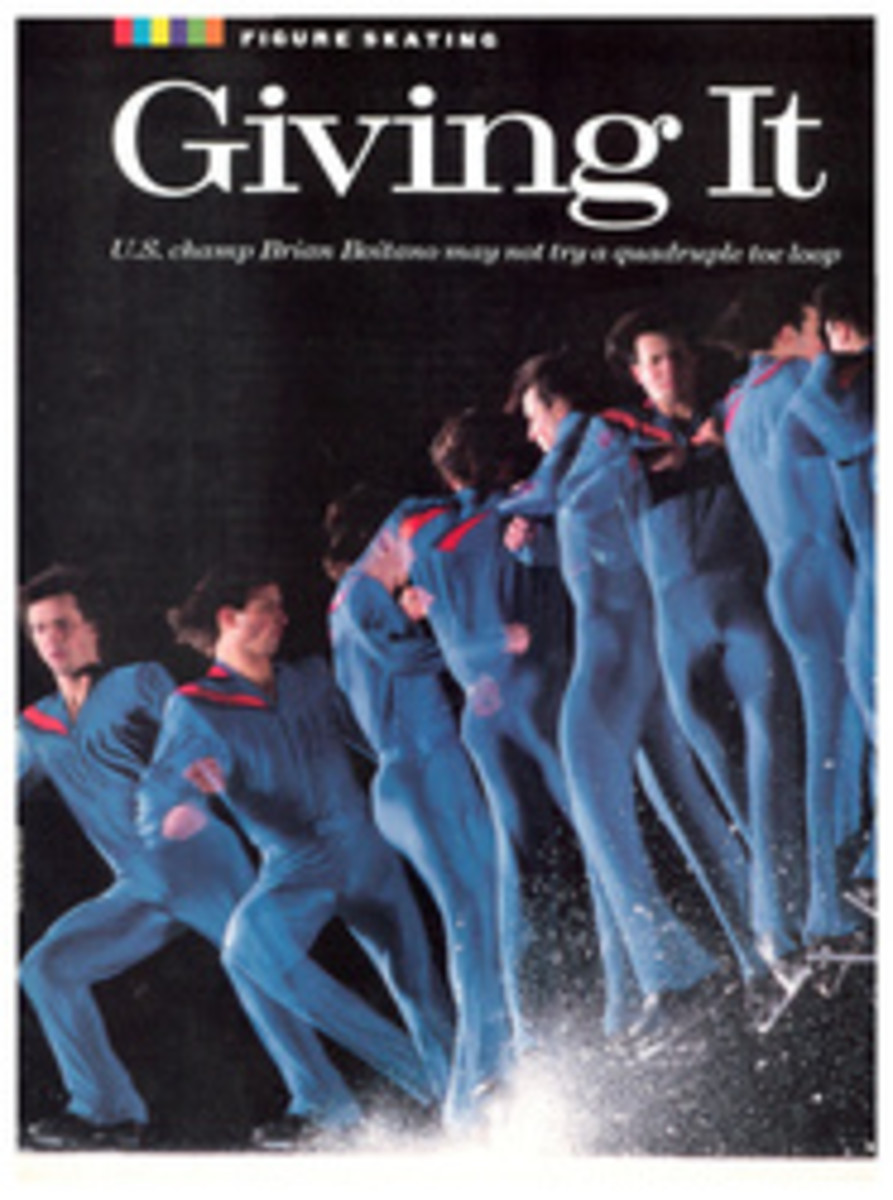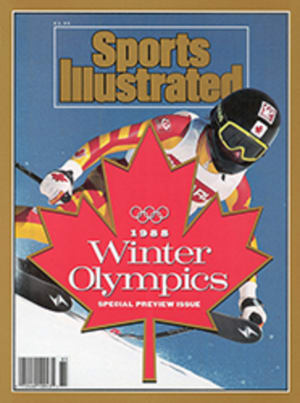
The Flying Dutchman
Last valentine's day, at the thialf indoor stadium in Heerenveen, the Netherlands, red roses, yellow daffodils and multihued tulips came showering down on the ice for a young man with whom the whole nation seemed to have fallen in love. The bouquets were thrown by a sellout crowd of 16,000 that had paid $20 a head to watch the World Speed Skating Championships. The cheering spectators had just witnessed their countryman, 21-year-old Leo Visser, clock 6:47.01 in the 5,000-meter race, breaking by more than two seconds the world record set by Viktor Shasherin of the Soviet Union in 1984.
They are mad about speed skating in the Netherlands. There are 14 million Dutch, and though it had been a fine Saturday afternoon, 3½ million of them had stayed indoors to watch the championships on TV At the Thialf oval, as Visser went for the record, a big drum banged out the rhythm of his stride as the fans roared. "Le-o! Le-o!"
"In the last few laps it hurt my ears," Visser said later. "They told me the crowd noise hit 120 decibels, which is more than a yet."
A what?
"You know, a yet fighter plane," said Visser.
Weeks after the championships, flowers and cards—50 or 60 a day—were still arriving at Visser's home in Haastrecht (pop. 4,450). But soon after the start of the current World Cup season, the cheering abruptly stopped. Early in December at Calgary's new indoor oval, the site of the Olympic competition, Visser's archrival, Geir Karlstad of Norway, broke Visser's world record in the 5,000 (6:43.59) and his own record in the 10,000 (improving it from 14:03.92 to 13:48.51). The young Dutchman placed third in the former event and fifth in the latter, a whopping 27 seconds behind the Norwegian. Leo, wasn't that, well, just a little disheartening?
Visser turned on the patient look that he employs when he has to explain the subtleties of his sport to a layman. "This is something they don't understand, even in Holland," he said with a sigh. "O.K., Karlstad sets two world records. I tried for the 10,000 record [in Calgary] also, but at seven kilometers I realized my lap times were too high, so I coasted after that. Those 27 seconds were not as bad as they sound because I made a technical decision. I eased back. I didn't have the legs that day to take the record.
"But my legs will be better than Karlstad's legs by the Olympics. That is because he works at a steady level right through the season. We Dutch work to a plan; we save ourselves for the real hard work after the New Year. We are timing our efforts to peak at the Olympics. And it is in the Olympics that I will beat Karlstad. And maybe take my record back also."
Holland is a tiny country. Drive out of Amsterdam on National Route 11, keep the Heineken brewery on your right, and you will arrive in Haastrecht in about half an hour. Anybody can direct you to the Visser home. There's probably only one other address in town that's better known—that of Hein Vergeer, the world speed skating champion in 1985 and 1986. Vergeer, 26, had a lot to do with the making of Leo Visser. "We practice together," says Visser. "We know each other very well. He's a great friend."
Visser began competing in junior 100-and 500-meter sprints at 10, but he didn't get serious about skating until he was 18. As he says, "When you stay up until 2 a.m. Friday nights discoing and drinking beer and then try to get up at 6:30 in the morning to train, well, you don't get very far." The turning point came almost accidentally, when Visser was the first in his peer group to pass the driver's test. Whereupon, Dutch drink-and-drive laws being fierce, he was conscripted as the nondrinking driver for the rest of the gang. He took out his frustrations at skating practice.
"So, the bar-disco part of my life is over," he says. "When I am 19, I make the junior national team, though I have not had so much training."
Visser progressed rapidly. "After only one winter on the junior team, he tried out for the national squad," says Holland's national coach, Henk Gemser. "It must have been the fastest anybody ever made it to the top in skating. I put him into the 1986 world championships at Inzell [West Germany]. I told him. 'Don't think about it. Just go in the competition. Just do what you can.' But he finished in eighth place! In the worlds!
"I was very excited. I knew I had found a great skater. It is not that his technique is so special. It is his fighting character that is his strong suit. And his endurance."
For a time, however, it seemed as if the promise Visser had shown at Inzell might have been just a flash of sun on the ice. Young Dutchmen are subject to a military draft, and from March 1986 to the beginning of the skating season in October, a time when Visser should have been preparing for his first winter of World Cup racing, he was stomping on the parade grounds at boot camp in Nijmegen and later standing guard at the military airport at Soesterberg. Then in October he came down with the flu as he tried to work his way back into form.
When he recovered he tried to make up for lost time and, predictably, he overtrained and lost confidence. Suddenly, he found he couldn't take curves at high speed. It took a friendship to snap this string of evil luck. Visser recalls how Jan Van Ykema, himself a candidate for a place on the Dutch national team, took him in hand. "He pulled me along with him for 200 meters, then straightened out to let me get inside and by him," Visser says. "And afterward he said. 'See? You can hit those curves fine.' It is wonderful to be able to look back on such friendship."
And so, last winter the assurance and the world-class times returned—and then came the flowers on the ice at Heerenveen. (Visser actually broke two world records that weekend: Besides the 5,000, he skated the 10,000 in 14:11.63, .51 under the mark held by Karlstad, but the Norwegian reclaimed it 14 minutes later with his 14:03.92.)
Over the summer, Visser kept his legs in shape by various methods, though not cycling—a traditional dryland exercise for speed skaters. "Too dangerous," he says. "Who wants to break a collarbone just ahead of an Olympic season? In summer I sprint, I walk, I roller-skate. We don't use regular roller skates with two pairs of wheels, but heavy ones with four wheels in line. The effect is of heavy ice skates."
Like a skateboard? Visser is shocked. "Ne, ne, ne!" he says, reverting to Dutch. "Very dangerous! Also not compatible with skating. You are using your legs for balance only in skateboarding. Your shoulders do that for you on ice."
Visser loves to talk about the technical aspects of skating. "Look at these skates." he says, holding up a pair of speedskates. "The irons are half as long again as a hockey or a figure skate. The shoe is also much different. It is from soft leather, just stiffened in places. We need more feeling in the shoe, for balance, because of the long irons. With hockey you skate with a quick movement. But we racers have to stay much longer on one foot."
Though he lost his world record at Calgary's indoor oval, Visser is clearly looking forward to skating there in the Olympics. He expects to be ready, and he figures the conditions will be right. "Perfection of ice for speed skating comes only at precise temperatures," he says with relish. "To be perfect, the underlevel of the ice must be around minus 11 [12° F] and the upper at minus three or minus two [26°-28° F]. If the ice is too cold, it's too hard, not wet enough to glide on well. If the ice is too warm, you have too much water. But indoors you can make it what you want."
The lecture might go on, but 20-year-old Yolande Grimbergen is waiting. She is also a speed skater and the Dutch youth champion (under 20), but it doesn't look as if she'll be competing at Calgary. "I have overstepped my ankle, and I have something with my knee," she says plaintively, if mysteriously. Leo will do well in the Olympics, she says, because he has the great mentaliteit (the winning attitude).
In Calgary skating fans will see whether the Dutch mentaliteit can overcome the Norwegian Karlstad.
PHOTO
STEVE POWELL/ALL-SPORT
MUSCULAR THIGHS POWER VISSER THROUGH THE GRUELING LONGDISTANCE EVENTS
PHOTO
STEVE POWELL/ALL-SPORT
YOLANDE HELPS LEO KEEP UP WITH ALL THE MAIL AND FLOWERS FROM HIS MYRIAD FANS
PHOTO
STEVE POWELL/ALL-SPORT
IN WARM WEATHER VISSER STRAPS ON ROLLER SKATES AND WHEELS ALONG THE ROADS NEAR HAASTRECHT
THREE ILLUSTRATIONS

